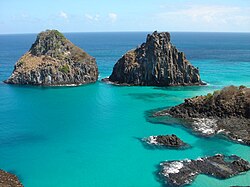This article includes a list of general references, but it lacks sufficient corresponding inline citations .(October 2023) |

A cove is a small bay or coastal inlet. They usually have narrow, restricted entrances, are often circular or oval, and are often situated within a larger bay. [1] Small, narrow, sheltered bays, inlets, tidal creeks, or recesses in a coast are often considered coves. [2] [3]
Contents
Colloquially, the term can be used to describe a sheltered bay. Geomorphology describes coves as precipitously walled and rounded cirque-like openings like a valley extending into or down a mountainside, or in a hollow or nook of a cliff or steep mountainside. A cove can also refer to a corner, nook, or cranny, either in a river, road, or wall, especially where the wall meets the floor.


